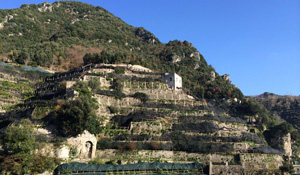

The Costiera Amalfitana was inscribed on the UNESCO World Heritage List (WHL) in 1997, in the "Cultural Landscape" category, “considering that the Costiera Amalfitana is an outstanding example of a Mediterranean landscape, with exceptional cultural and natural scenic values resulting from its dramatic topography and historical evolution. "(criteria ii, iv and v).
The former Superintendence for Architectural and Landscape Heritage for the provinces of Salerno and Avellino and the Comunità Montana Penisola Amalfitana (now suppressed and replaced by the Comunità Montana Monti Lattari) first stipulated a memorandum of understanding, then concretely supported first the preliminary studies then the preparation of the Management Plan (MP) wanted by the Ministry for Cultural Heritage and Activities to adapt the sites included in the WHL to the UNESCO directives. On behalf of these bodies, the European University Centre for Cultural Heritage of Ravello has set up a Working Group (WG), made up of scholars from Italian universities (Federico II University, Second University of Naples, Rome University 3, University of Salento), to national research bodies (CNR IRAT and IAMC) and to the UNESCO advisory body ICOMOS. The WG then carried out the preliminary studies and drew up a first draft of the MP, thus issuing the final version, submitting it to the Mayors and stakeholders of the area.
The MP "Amalfi Coast" was therefore launched with a precise vision: to reactivate the process of intelligent and compatible adaptation of the territory to the needs of the community that uses it. Towards The Ancient Coast is the slogan that defines it.
The methodological aspects of this approach, the critical issues to be resolved (the nature of a public good such as a cultural landscape, which however is generated and used by private individuals; the possible support policies for agriculture through the equalization with the tourist activities that it stimulates; the methods of use of renewable energy sources in a territory that is a paradigm of their intelligent use in ancient times, but which today cannot be invaded by them), the analysis of governance models and of the MP of other Italian and Europeans MPs and were the subject of the book "THE FUTURE OF ANCIENT TERRITORIES - PROBLEMS, PERSPECTIVES AND GOVERNANCE ISSUES OF LIVING EVOLVING CULTURAL LANDSCAPES" ", published in the series" Historical Territory and Environment "of the European University Centre for Cultural Heritage.
In September 2019, the Center published the Management Plan, whose structure is divided into a first part, which exposes the characteristics of the system to be governed and the issues of government that derive from it, and in a second part, which illustrates the whole of the planned interventions. The second part represents the body of the PdG, whose 66 interventions concretize the 36 actions necessary to achieve the 10 strategic objectives. Each of the proposed interventions is described according to a detailed form, which outlines the structure and contents (purpose, articulation, expected results, actors, costs etc.) referring to the actions they concretize and the objectives they are aimed at. Each sheet indicates on the one hand the activities to be carried out with references to the 5 sectors suggested by UNESCO (Knowledge; Protection and conservation; Enhancement; Promotion, Training and Communication; Monitoring), on the other the basic elements for the political decision maker called to implement it: priority, duration and costs (useful for including the intervention in a reliable time schedule); impact generated on the territory (in reference to the landscape) and on the community (in terms of both usability and consensus / dissent that the intervention can generate). The form is also completed by the success indicators, necessary to make monitoring concrete and effective. Finally, the time schedule of the actions to be carried out, the monitoring criteria, the frequency of any revisions, the estimated costs are proposed.

 English (UK)
English (UK)  Italian (IT)
Italian (IT) 




